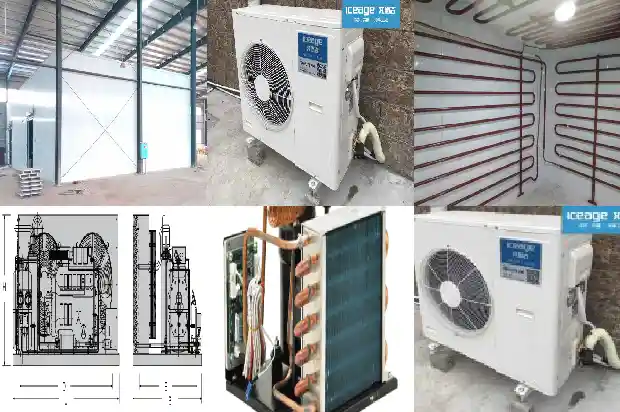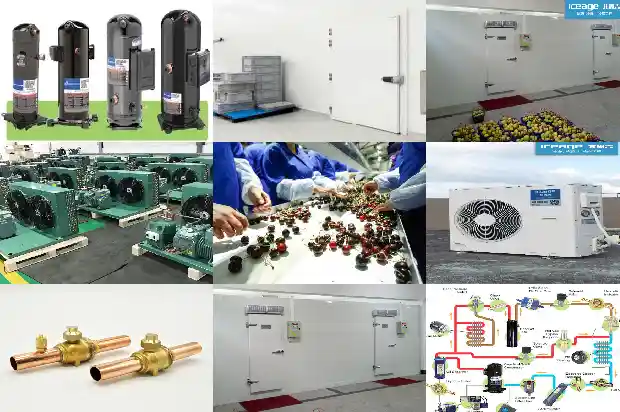Do You Know These Four Scenarios That Can Cause Compressor Failures?
2025-01-11
- Insufficient Cooling
Compressors with relatively high power are generally of the suction gas cooling type. The lower the evaporation temperature, the smaller the system mass flow tends to be. When the evaporation temperature is very low (exceeding the manufacturer's regulations), the flow rate is insufficient to cool the motor, and the motor will operate at a higher temperature. Air - cooled compressors (generally not exceeding 10HP) have less dependence on suction gas but have clear requirements for the compressor ambient temperature and cooling air volume.
A large amount of refrigerant leakage can also cause a reduction in the system mass flow, and the cooling of the motor will be affected. For example, it can cause the compressor to protect due to excessive discharge temperature.
Compressors all have a safe operating condition range.
The main consideration factors for safe operating conditions are the load and cooling of the compressor and the motor. Since the prices of compressors for different temperature zones are different, it was relatively common in the domestic refrigeration industry to use compressors beyond the specified range in the past. With the growth of professional knowledge and the improvement of economic conditions, the situation has improved significantly.
- Power Phase Loss and Voltage Abnormality
Abnormal voltage and phase loss can easily damage any motor. The power supply voltage variation range should not exceed ±10% of the rated voltage. The voltage imbalance among the three phases should not exceed 5%.
High - power motors must be independently powered to prevent low voltage caused by the startup and operation of other high - power equipment on the same line. The motor power cord must be able to carry the rated current of the motor.
If the compressor is running when a phase loss occurs, it will continue to operate but with a large load current. The motor windings will overheat quickly, and under normal circumstances, the compressor will be protected by the thermal protection device. When the motor windings cool down to the set temperature, the contactor will close, but the compressor cannot start, resulting in locked - rotor, and entering a "locked - rotor - thermal protection - locked - rotor" dead cycle.
To prevent the compressor from running with a phase loss, three - phase - powered compressors are equipped with a phase - sequence protector. The phase - sequence protector has two functions: one is to prevent the compressor from running in reverse due to incorrect phase sequence; the other is to prevent the compressor from running with a phase loss.
The differences in modern motor windings are very small. When the power supply is three - phase balanced, the differences in phase currents can be ignored. Ideally, the phase voltages are always equal, and as long as a protector is connected to any one phase, damage caused by over - current can be prevented. In reality, it is difficult to ensure the balance of phase voltages. The calculation method for the voltage imbalance percentage is the ratio of the maximum deviation value of the phase voltage from the average value of the three - phase voltages to the average value of the three - phase voltages. For example, for a nominal 380V three - phase power supply, the voltages measured at the compressor terminal are 380V, 366V, and 400V.
The average value of the three - phase voltages can be calculated as 382V, and the maximum deviation is 20V, so the voltage imbalance percentage is 5.2%.
As a result of voltage imbalance, during normal operation, the imbalance of the load current is 4 - 10 times the percentage of voltage imbalance. In the previous example, a 5.2% voltage imbalance may cause a 50% current imbalance. - AC Contactor Problems
The AC contactor is one of the important components in the motor control circuit. Improper selection can damage the best compressors. It is extremely important to select the contactor correctly according to the load.
AC contactors must be able to meet harsh conditions, such as rapid cycling, continuous overload, and low voltage. They must have a large enough area to dissipate the heat generated by the load current, and the selection of contact materials must prevent welding under high - current conditions such as startup or locked - rotor.
For safety and reliability, the compressor contactor should disconnect the three - phase circuit simultaneously. Copeland does not recommend the method of disconnecting the two - phase circuit.
The rated current of the contactor should not be lower than the rated current on the compressor nameplate. Contactors with small specifications or poor quality cannot withstand the large - current impact during compressor startup, locked - rotor, and low - voltage, and are prone to single - phase or multi - phase contact jitter, welding, and even falling off, causing motor damage.
Contactors with jittery contacts start and stop the motor frequently. Frequent motor startup, with huge starting currents and heat generation, will accelerate the aging of the winding insulation layer. Each time the motor starts, the magnetic torque causes slight movement and mutual friction of the motor windings. If other factors are present (such as metal chips, lubricating oil with poor insulation, etc.), it is easy to cause short - circuits between windings. The thermal protection system is not designed to prevent this kind of damage. In addition, the coils of jittery contactors are prone to failure. If a contact coil is damaged, a single - phase state is likely to occur.
If the contactor is selected to be too small, the contacts cannot withstand the arc and the high temperature generated by frequent on - off cycling or unstable control circuit voltage, and may weld together or fall off from the contact holder. Welded contacts will create a permanent single - phase state, causing the overload protector to continuously cycle on and off.
It should be emphasized that after the contactor contacts are welded, all controls that rely on the contactor to disconnect the compressor power supply circuit (such as high - low pressure control, oil pressure control, defrosting control, etc.) will fail completely, and the compressor will be in an unprotected state. Therefore, when the motor is burned out, the contactor must be checked. The contactor is an important but often overlooked cause of motor damage.
After the AC contactor contacts stick together, the compressor will operate regardless of whether the main board has an output. Running without protection for a long time makes compressor damage inevitable. When replacing the compressor, it is necessary to find out the cause of the compressor damage, and check whether the AC contactor is normal, whether there is phase loss and sticking. One cannot just replace the compressor without delving into the cause, which is bound to lead to the secondary damage of the newly replaced compressor. - Compressor Oil Deficiency
Oil deficiency is one of the easily distinguishable compressor failures. When the compressor is short of oil, there is very little or no lubricating oil in the crankcase, and the compressor is likely to burn out.
Oil deficiency can cause serious lubrication shortage. The root cause of oil deficiency does not lie in how much and how fast the compressor loses oil, but in poor system oil return. Installing an oil separator can return oil quickly and extend the operation time of the compressor without oil return. The design of the evaporator and the return air pipeline must consider oil return. Maintenance measures such as avoiding frequent startup, regular defrosting, timely refrigerant replenishment, and timely replacement of worn piston components also contribute to oil return.
Liquid return and refrigerant migration will dilute the lubricating oil, which is not conducive to the formation of an oil film; oil pump failures and oil passage blockages will affect the oil supply and oil pressure, resulting in oil deficiency on the friction surface; high temperatures on the friction surface will cause the lubricating oil to decompose, making the lubricating oil lose its lubricating ability. The lubrication shortage caused by these three aspects of problems often also causes compressor damage.
Related Articles
- Have You Encountered the Three Common Problems of Refrigeration Compressors?
- What to Do if the Compressor of a Frozen and Refrigerated Display Cabinet Runs but the Refrigeration Effect Is Poor?
- What to Do if the Compressor of the 【Refrigerated and Frozen Display Cabinet】 Unit Fails to Start?
- Precautions for Using Rotary Refrigeration Compressors
- How to Resolve the Scuffing Issue of Cold Storage Compressors
- Composition and Common Faults of Screw Refrigeration Compressors
- What Are the Causes of Scroll Compressor Damage?
- What Are the Reasons for Insufficient Air Output of Screw Air Compressors?
- How to Solve the Problem of Frequent Shutdown and Startup of Cold Storage Compressors?
- How to Schedule Overhauls, Medium - sized and Minor Repairs of Screw Refrigeration Compressors?
- Why Can't Compressors Start Directly? What Are the Advantages of Soft Starters?
- Maintenance Methods for Faults in Screw Refrigeration Air - conditioner Compressors
- Solutions to Common Compressor Failures
- Effective Measures to Prevent Compressor Failures in Industrial Chillers
- Common Faults and Troubleshooting Methods of the Moving Mechanism of Piston Compressors
- Common Causes and Analysis of Compressor Thermal Protection
- Analysis of Common Faults in Compressor Overcurrent and Burnout
- Reasons for Pump Body Failures in Cold Storage Compressors
